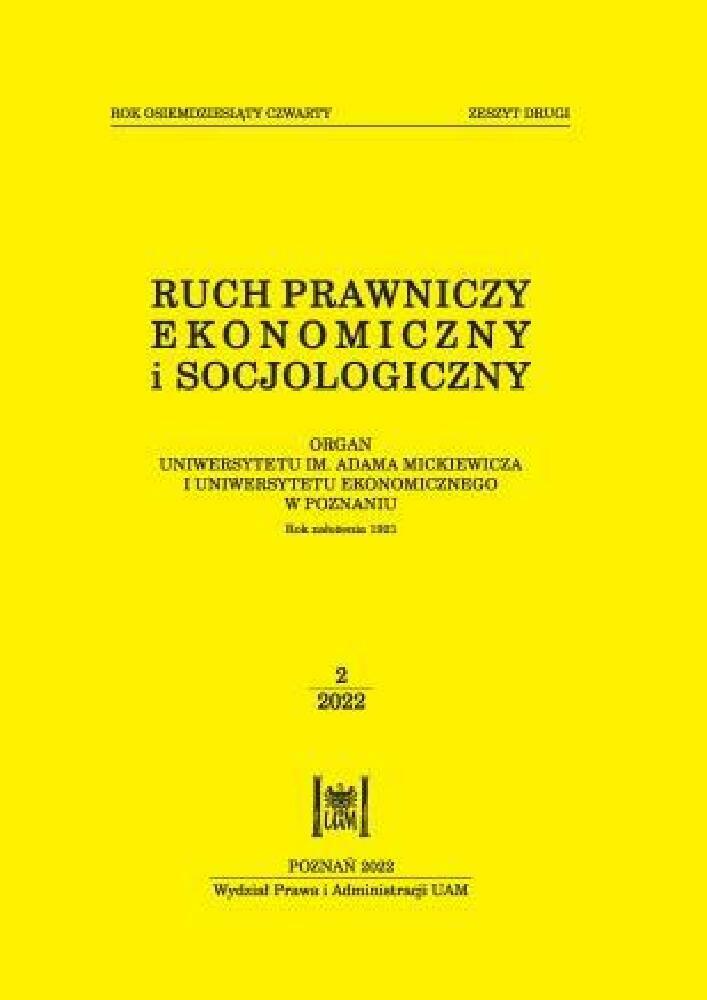Abstrakt
Celem prowadzonych rozważań jest uzasadnienie sformułowanego postulatu wyodrębnienia w polskim systemie prawnym autonomicznego typu przestępstwa obejmującego podrobienie albo przerobienie bądź nielegalną reprodukcję dzieła sztuki, które kompleksowo – podobnie jak w wypadku ochrony zabytków, a może nawet szerzej – obejmowałoby najważniejsze fazy tego zachowania, uwzględniając również i te o ubocznym charakterze, związane z wprowadzeniem falsyfikatu do obrotu lub jego rozpowszechnieniem. Dla prowadzonych rozważań pojęcie dzieła sztuki zawężone zostało do dzieł sztuki plastycznej, a przez „dzieło sztuki” rozumie się samodzielny przedmiot oddzielony od innych przedmiotów o indywidualnej i niezależnej specyfice, stworzony przez człowieka, posiadający wartość estetyczną i wyrażający walory emocjonalne (M. Gołaszewska, Zarys estetyki. Problematyka, metody, teorie. Warszawa 1986: 277). W poszczególnych częściach artykułu przedstawiono najważniejsze problemy związane z uruchomieniem karnoprawnej ochrony w razie realizacji przez sprawcę zachowania określanego powszechnie jako „fałszerstwo dzieła sztuki”. W prowadzonych badaniach wykorzystano przede wszystkim metodę dogmatyczną oraz w węższym zakresie historyczną i komparatystyczną. Finalnie ustalono, że układ interesów prawnych wokół aktualnych reguł funkcjonowania rynku sztuki sprawia, że zakres ochrony prawnej dzieła sztuki, w tym również zabytku w razie fałszerstwa, w równej mierze powinien koncentrować się na prawach nabywców – jak dotychczas – ale także powinien uwzględniać prawa twórców oryginałów, tak aby mogli w razie ich naruszenia skutecznie reagować. W rezultacie, dostrzegając potrzebę interwencji legislacyjnej także wobec przestępstwa przerobienia albo podrobienia zabytku oraz przestępstwa zbycia falsyfikatu zabytku, wskazano na konieczność wprowadzenia do polskiego systemu prawnego autonomicznego typu przestępstwa fałszerstwa działa sztuki.
Bibliografia
Alibrandi, T., Ferri, P.G. (2001). Ibeni culturalied e ambientali. Milan.
Bednarzak, J. (1971). Przestępstwo oszustwa w polskim prawie karnym. Warsaw.
Bednarzak, J. (1972). Znamiona przestępstwa oszustwa. Nowe Prawo 5: 695–710.
Casini, L. (2017). Valorizzazione e gestione, [in:] C. Barbati, M. Cammelli, L. Casini, G. Piperata, G. Sciullo, Diritto del patrimonio culturale. Bologna: 191–242.
Falsyfikaty malarskie (1911). Świat 17: 5–6.
Gerecka-Żołyńska, A. (2019). Definicja “zabytku”, pojęcie „dzieła sztuki” – znane problemy, nowe wyzwania, [in:] A. Gerecka-Żołyńska A. (ed.) Restytucja zabytków w Polsce. Ograniczenia i perspektywy. Poznań: 61–76.
Golka, M. (1991). Rynek sztuki. Poznań.
Gołaszewska, M. (1986). Zarys estetyki. Problematyka, metody, teorie. Warsaw.
Kowalski, W. (2015). Wartość jako kryterium kwalifikacyjne zabytku w prawie wewnętrznym i międzynarodowym, [in:] B. Szmygin (ed.), Systemy wartościowania dziedzictwa: stan badań i problem. Lublin: 111–137.
Maccari, A.L. (2006). Il falso d’arte nel nuovo Codice dei Beni Culturali e del Paesaggio, [in:] Piergigli V., Maccari A. L. (eds.), Il Codice dei Beni Culturali e del Paesaggio tra teoria e prassi. Milan: 455–826.
Moramarco, R. (2015). Commento all’art. 178 “Contraffazione di opere d’arte”, [in:] G. Famiglietti, N. Pignatelli (eds.), Codice dei beni culturali e del paesaggio. Bologna: 1125–1155.
Ożóg, M. (2020). Uwagi o instytucjonalnej ochronie pośmiertnych autorskich dóbr osobistych, [in:] M. Jankowska, P. Gwoździewicz-Matan, P. Stec (eds.), Własność intelektualna a dziedzictwo kulturowe. Księga jubileuszowa dedykowana Profesorowi Wojciechowi Kowalskiemu. Warsaw: 213–231.
Zwolińska, K., Malicki, M. (1990). Mały słownik terminów plastycznych. Warsaw.
Licencja
Prawa autorskie (c) 2022 WPiA UAM

Utwór dostępny jest na licencji Creative Commons Uznanie autorstwa – Użycie niekomercyjne – Bez utworów zależnych 4.0 Międzynarodowe.





